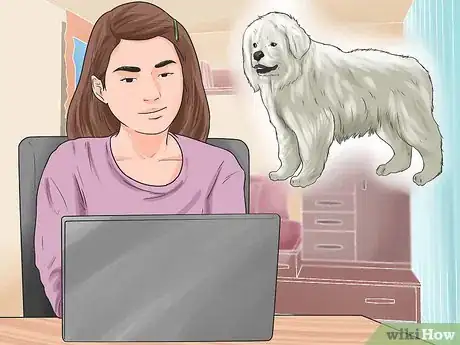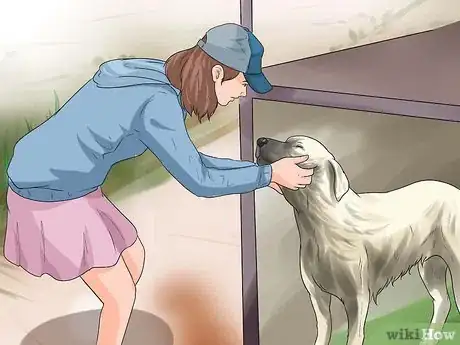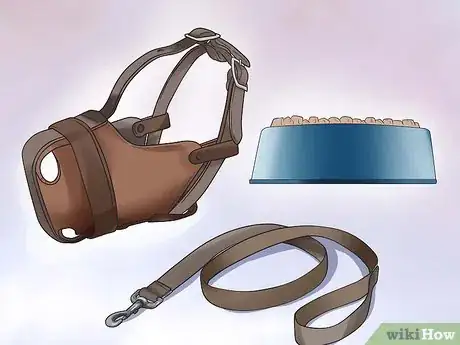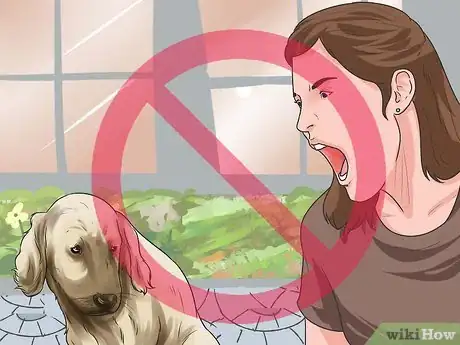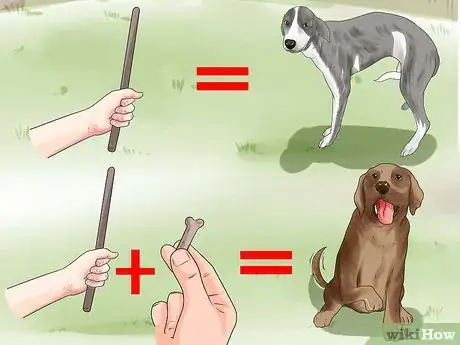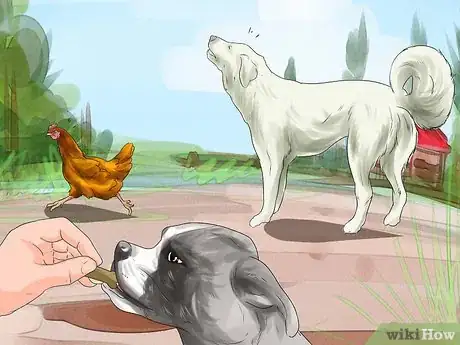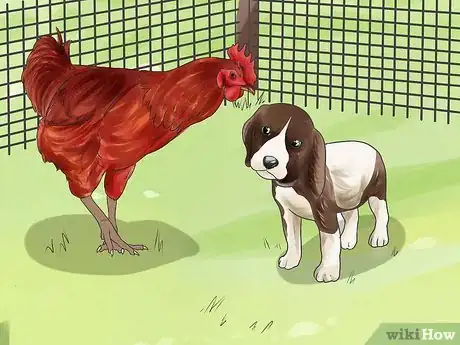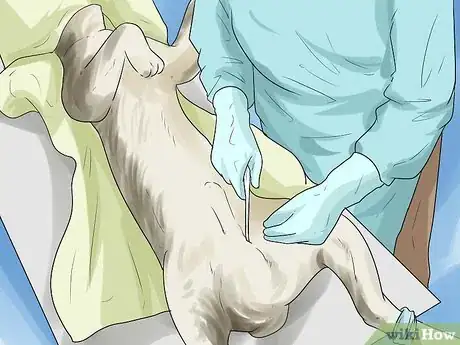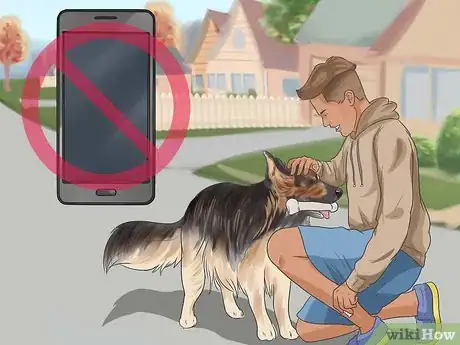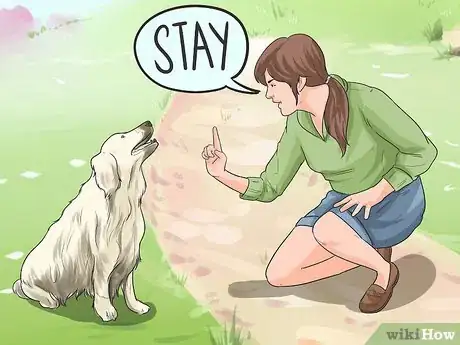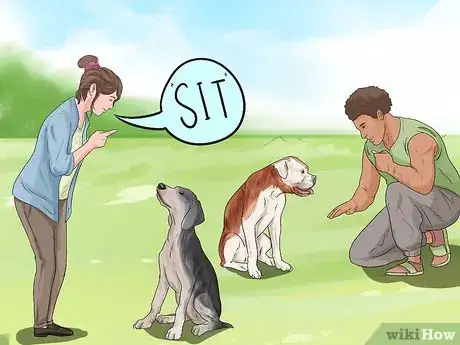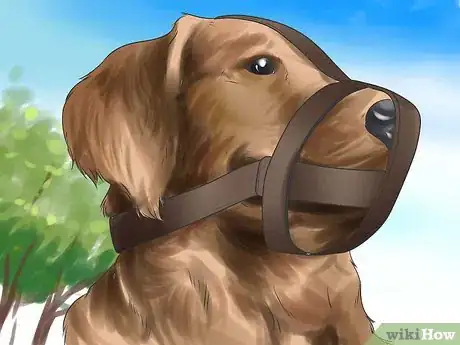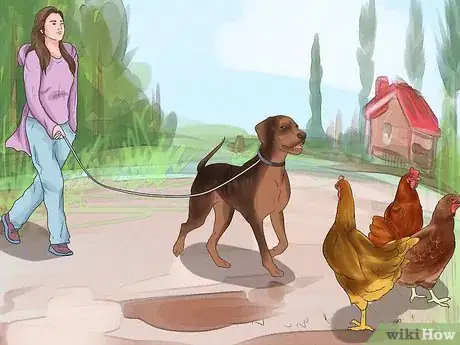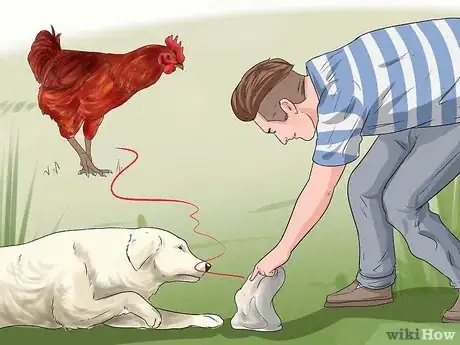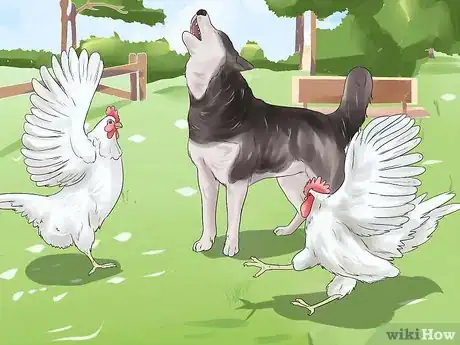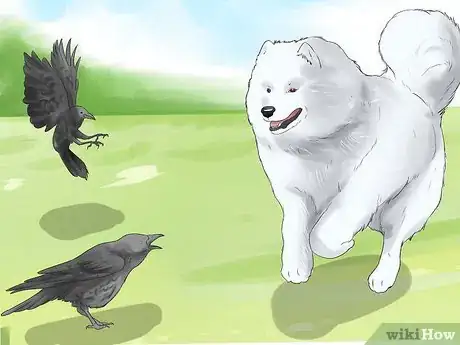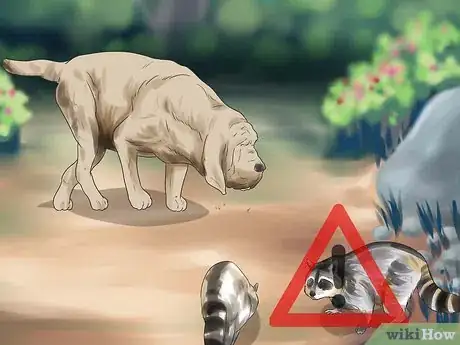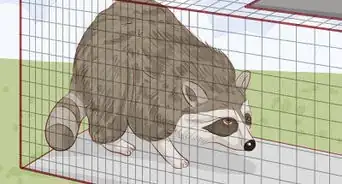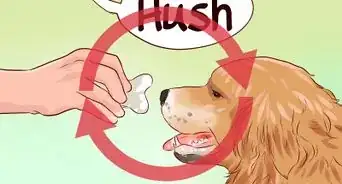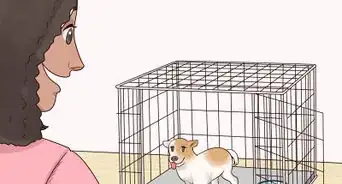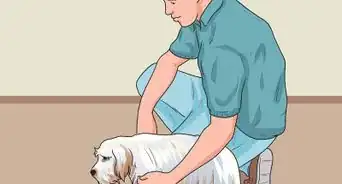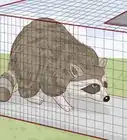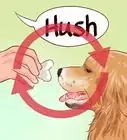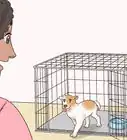This article was co-authored by Jennifer Schneider. Jennifer Schneider is a Dog Behavior and Training Expert, as well as the Owner of Pick of the Litter Dog Training. With over 25 years of experience, she specializes in positive, dog-friendly training. She holds a BA in Psychology with an Emphasis on Animal Behavior from the University of Washington, and she’s a Certified Professional Dog Trainer (CPDT).
There are 7 references cited in this article, which can be found at the bottom of the page.
This article has been viewed 95,241 times.
If you have ever owned chickens, you know the horror and risk of a hawk or crow getting a favorite chick, or a raccoon coming in the middle of the night and devouring your whole flock. If you have a dog, or you're planning to get one, you can help keep your chickens safe and give your dog valuable skills by training it to protect your chickens.
Steps
Preparing Your Dog for Protecting Poultry
-
1Research dog breeds. This is important even if you already have a dog. Certain breeds of dog are trained to be more prey driven than others, which makes these dogs less trustworthy around your flock. Knowing if your dog is prey driven will prepare you for the careful and consistent training dogs of that temperament require.[1] Some of the best dogs for guarding chickens are:
- Great Pyrenees
- Maremma Sheepdog
- Akbash
- Kuvasz
- Komondor
- Polish Tatra Sheepdog
- Anatolian Shepherd
- Kangal
-
2Get a dog to train, or train your current one. It is easiest to train a dog from puppy to adult, but if you think your dog has what it takes, consistent and clear training might be all your dog needs. When training your dog, remember to:
- Use succinct commands - repeating a command over and over can teach your dog to ignore you.
- Reward generously - positive reinforcement, like a treat or verbal praise, can curb aggressive tendencies and instill obedient response.[2]
- Train cheerfully - dogs are sensitive to human tone of voice and body language. Your dog is your comrade and a partner with you in the training experience; kind treatment will go a long way toward obedient response.
Advertisement -
3Gather the right tools for the job. There are many different opinions on the best training method for any dog, but when it comes down to it, every dog is going to be different. Trust your instincts and your knowledge of your animal, but consider using the following tools to assist in training:
- Collar
- Leash
- Muzzle (optional)
- Shock collar (optional)
- Treats (for reward)
-
4Be mindful of puppy psychology. It can be effective to plan your training to occur prior to meals. This way, your dog will be a little hungrier than normal, which will make him more attentive to the treats you are using as a reward. If your dog ever seems as though he's overheated, tired, or too rambunctious, it's best not to force your training.[3]
- If you become frustrated during the course of your training session with your dog, don't get angry with or yell at him unnecessarily.[4] Dogs with soft temperaments might become anxious or stop paying attention to trainers who yell without reason. If you are frustrated, simply end your session early and try again later.
-
5Know the benefits of positive reinforcement training. This kind of training relies on treats to encourage your dog to perform training exercises and respond to cues, like a spoken command, sound, or gesture.[5] [6] The more irresistible a treat is, the more motivated your dog will be to earn it, so you should experiment to find the treat your dog will work hardest for.[7] Once you have a suitable treat, like small pieces of cut up hot dog or dog biscuits, To train using positive reinforcement you should:
- Illustrate the training goal to your dog. You may have to raise a paw to show it how to "shake hands," or you may raise a treat above your dog's head, causing its rump to lower to the ground while issuing the command: "Sit."
- Reward immediately for responding to a cue/command.
- Use the same set of cues/commands between all family members.[8] [9]
-
6Be prepared to reinforce chicken related good behavior. Whenever your dog responds to one of your cues/commands, especially those related to your chickens, have a treat ready to reward it. Only reward specific good behavior; you don't want your dog to associate a negative action, like barking or chasing your chickens, with receiving a treat.[10]
Training a Poultry Protector
-
1Desensitize your dog in a controlled environment. The more distractions there are, the more difficult it will be for you to hold your dog's attention while training. At the age of 9 weeks, most expert trainers begin exposing to livestock in a safe, fenced in area. This way your puppy can become more comfortable with your chickens.
-
2Fix your dog when age appropriate. This is especially important for male dogs. Without neutering, male dogs can suffer from aggression and distracted behavior. By limiting the aggressive hormones of your dog by getting it fixed, your pup's chicken guard training will go much more smoothly.[11]
-
3Train with as few distractions as possible. If you are rushed, you may get more easily irritated than normal with your puppy's progress, which can have a negative impact on training. Interruptions, too, like your cell phone, can lead to confusion during a training session.[12]
-
4Teach basic commands. Your dogs should know all basic commands, like sit, down, come, and stay before you allow your grown (or growing) dog to go toe-to-talon with your chickens. These can most effectively be trained through short training sessions that use positive rewards paired with clear, succinct commands. The most important command, however, in the vocabulary of a poultry protector is probably: leave it.
- The leave it command can be trained with meat, cheese, or some other kind of treat. Collect a goodly amount of treats, and then place your dog into position.
- Place a treat in front of your dog and command him to leave it.
- When the dog makes his move for the meat, block it with your hand and give a firm, negative response, like "Ah" or "No."
- When your dog appears to have lost interest in the temptation, reward your him with a different piece of meat from your other hand.
- Move the temptation closer and repeat this process.[13]
-
5Ingrain basic commands in your dog. It might take a while before your dog learns anything more than sit, but alternating between commands quickly can be fun for your dog while further entrenching the command. Alternate between sit and down or sit and come to train your puppy as you play.[14]
Protecting that Poultry
-
1Consider a muzzle. Though some believe a muzzle to be inhumane, many trainers regard it as a suitable tool for a suitable purpose, just like a dog collar or a leash.[15] If you have trouble with your dog pursuing chickens with the intent to kill or eat them, a muzzle will make training safest for all of your animals.
-
2Introduce your dog to chickens in the coop, gradually. If your dog is especially excitable, you may want to keep him on a leash until he becomes calmer around your birds.[16] Take him with you on your feeding chores to help him become even more accustomed to the chickens and the chickens more accustomed to him.
- Exercise simple commands like the compound sit-stay. You may want to practice this while entering the chicken coop to fetch your eggs, which has the added benefit of teaching your dog not to invade the boundary of the chicken coop.[17]
-
3Familiarize your dog with chicken scent. You can do this by rubbing down your chickens with damp cloth and putting that cloth in your dog's bed or pen. Dogs have a powerful sense of smell, so the scent of the chickens, when unfamiliar, can cause a strong reaction.[18]
-
4Teach your dog to break up rooster fights. While outside with your dog, you may see your chickens and/or roosters fighting. This is not especially uncommon, but can leave a valuable member of your egg laying team out of commission. With your dog on its lead, run towards the fighting animals and break up the scuffle. Once you have pulled the birds apart, practice one of your basic commands, or, if you've trained your dog in it, use the safe command.
- By showing your dog what to do in the event of a chicken fight, and rewarding him for helping you break it up, you will begin to teach him to run to help whenever he hears a chicken in distress.
-
5Raise awareness in your dog of chicken predators. Your dog already has a keen sense of some wildlife predators, but crows and chicken hawks can be just as dangerous to younger birds and chicks as a fox. Together with your dog on his lead, shoo away crows or any other birds of prey.
- After you have successfully chased away the birds, praise your dog and feed him a treat. This will positively reinforce the behavior to protect chickens from birds of prey.
-
6Allow your dog to patrol for raccoons. As your dog becomes more trustworthy and proves he understands your commands and also your expectations of how he should act around your birds, you should allow him to patrol for critters. Thanks to your training in how to break up a chicken fight, he will race to the sound of a chicken in distress and help.
-
7Exercise your dog. You can't expect your canine companion to keep the chickens in line if he's out of shape. Go for regular walks, continue short, rapid fire training sessions, and show your dog he's a beloved part of your pack.
Community Q&A
-
QuestionShould we eventually put a doghouse inside the chicken fence?
 Community AnswerYes, if your dog is friendly and won't eat the chickens.But no, if your dog is aggressive and is not trained well.
Community AnswerYes, if your dog is friendly and won't eat the chickens.But no, if your dog is aggressive and is not trained well. -
QuestionOur 7-month-old Pyrenees pup got a hold of one of our chickens and killed it. She ate one foot off and some of the body. After her doing this, can she ever be trusted to guard our chickens?
 Community AnswerShe could be trusted with guarding your chickens, but before that you need to train her a lot. I recommend supervising her while she is close to the chickens so that you can correct her if she gets aggressive toward the chickens. Try to get her used to being near the chickens and seeing them. If you teach her this, the instinct of protecting her masters and their territory should come by itself.
Community AnswerShe could be trusted with guarding your chickens, but before that you need to train her a lot. I recommend supervising her while she is close to the chickens so that you can correct her if she gets aggressive toward the chickens. Try to get her used to being near the chickens and seeing them. If you teach her this, the instinct of protecting her masters and their territory should come by itself. -
QuestionMy wife found our Anatolian eating one of our hens while I was out of town. Would she just start eating it if she found it dead?
 Kathy5421Community AnswerYes, because dogs are carnivores. They eat meat and other animals on the food chain. There is no way to stop this besides keeping the dogs away from the chickens.
Kathy5421Community AnswerYes, because dogs are carnivores. They eat meat and other animals on the food chain. There is no way to stop this besides keeping the dogs away from the chickens.
Warnings
- Some trainers believe that shock collars negatively impact the relationship between dog and owner.[19] Be that as it may, for older, aggressive dogs that don't take to chicken protection, this may be a means of keeping your flock safe.⧼thumbs_response⧽
- Chickens can get hurt by even well trained dogs. Keep your dog on a leash until you completely trust him and his ability to obey your commands.⧼thumbs_response⧽
Things You'll Need
- Collar
- Leash
- Muzzle (optional)
- Shock collar (optional)
- Treats (for reward)
Expert Interview
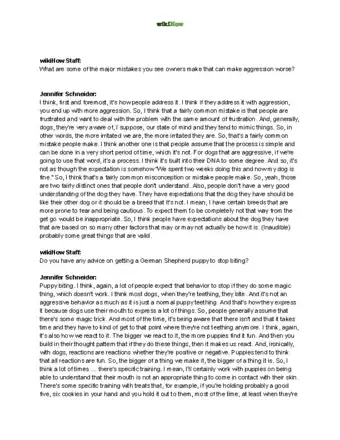
Thanks for reading our article! If you'd like to learn more about training a dog to protect other animals, check out our in-depth interview with Jennifer Schneider.
References
- ↑ http://www.backyardpoultrymag.com/training_dogs_around_poultry/
- ↑ http://www.humanesociety.org/animals/dogs/tips/dog_training_positive_reinforcement.html
- ↑ http://www.humanesociety.org/animals/dogs/tips/dog_training_positive_reinforcement.html
- ↑ http://www.humanesociety.org/animals/dogs/tips/dog_training_positive_reinforcement.html
- ↑ http://www.humanesociety.org/animals/dogs/tips/dog_training_positive_reinforcement.html
- ↑ http://behaviormatters.com/positive-reinforcement-animal-training/
- ↑ http://www.humanesociety.org/animals/dogs/tips/dog_training_positive_reinforcement.html
- ↑ http://www.puplife.com/pages/training-your-dog-with-positive-reinforcement
- ↑ https://www.cesarsway.com/dog-training/choosing-a-professional-trainer/the-dos-and-donts-of-positive-reinforcement
- ↑ http://pets.webmd.com/dogs/features/dog-training-positive-reinforcement-alpha-dog-method?page=3
- ↑ http://www.backyardpoultrymag.com/training_dogs_around_poultry/
- ↑ http://www.humanesociety.org/animals/dogs/tips/dog_training_positive_reinforcement.html
- ↑ http://www.backyardpoultrymag.com/training_dogs_around_poultry/
- ↑ http://www.backyardpoultrymag.com/training_dogs_around_poultry/
- ↑ http://www.backyardpoultrymag.com/training_dogs_around_poultry/
- ↑ http://thepaleomama.com/2015/06/the-training-of-a-livestock-guardian-dog/
- ↑ http://thepaleomama.com/2015/06/the-training-of-a-livestock-guardian-dog/
- ↑ http://www.backyardpoultrymag.com/training_dogs_around_poultry/
- ↑ http://www.backyardpoultrymag.com/training_dogs_around_poultry/
About This Article
To train a dog to protect chickens, get the dog fixed to prevent aggression and distracted behavior. Next, teach the dog basic commands like sit, down, come, and stay. Whenever your dog responds correctly to a command, reward it with a treat. Then, gradually introduce the dog to your chickens so it can get used to their presence and scent. Finally, show your dog what predators to protect the chickens from and how to break up a rooster fight. For tips on choosing the best dog breed for the job, read on!
